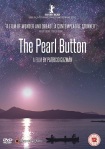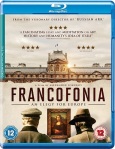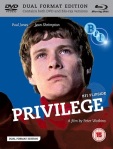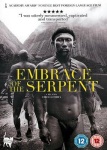A couple of years ago, I thought it might be a good idea to try and watch all the films on the 1001 Movies You Must See Before You Die list (the 2013 edition). This year I also decided to try and watch a film from as many countries as I could. Both challenges have been going quite well: I’ve watched 897 of the 1001 so far, 56 of them seen for the first time this year; and I’ve watched movies from 53 countries… although only Thailand, Kazakhstan, Lithuania, Venezuela, Mongolia, Georgia, Vietnam, Peru, Singapore, Jordan, Jamaica, Estonia, Cuba and Romania were new to me in 2017.
It also occurred to me in 2017 that most of the films I watched were directed by men. So I started to track the genders of the directors whose films I watch in an effort to see more films by female directors. Unfortunately, female directors are hugely outnumbered by men, especially in Hollywood, and I managed only 43 films by women during the year. Having said that, a couple of those female directors became names I plan to keep an eye on, such as Claudia Llosa and Lucía Puenzo.
films
I watched 602 films in 2017, although only 532 were new to me this year. I also decided in 2017 to watch more documentaries, and ended up watching so many that I thought it best to split my film best of the year lists into two, one for documentaries and one for “fictional” films… except I’m not sure what to call the latter, but I think “narrative cinema” is the preferred term.
documentary
 1 I am Cuba, Mikhail Kalatozov (1964, Cuba) [1]. I loved Humberto Solás’s Lucía after watching it, and I wanted to see Tomáz Guttiérez Alea’s Memories of Underdevelopment a second time, and there was this box set from Mr Bongo that included both, as well as I am Cuba and Strawberry and Chocolate. So I bought the box set… and was blown away when I watched I am Cuba, a documentary commissioned by the Soviets to promote Cuba, but which was so innovative it was never actually released. Kalatozov reportedly strung cameras on wires, but even knowing that it’s hard to work out how he achieved some of his shots. And this was in 1964, when there was no CGI. I am Cuba also presents the island as a near-utopia, and while the USSR and its satellite nations were never that, they at least aspired to it – which is more than can be said of the West. The American Dream isn’t utopia, it’s a deeply mendacious justification for the success of the few at the expense of the many. Even now, 53 years after I am Cuba was made, Cuba remains poor, but has one of the best free healthcare systems on the planet, and the US is rich and its healthcare system is unaffordable by the bulk of its population. Some things are more important than giving a handful of people the wherewithal to buy their own Caribbean island.
1 I am Cuba, Mikhail Kalatozov (1964, Cuba) [1]. I loved Humberto Solás’s Lucía after watching it, and I wanted to see Tomáz Guttiérez Alea’s Memories of Underdevelopment a second time, and there was this box set from Mr Bongo that included both, as well as I am Cuba and Strawberry and Chocolate. So I bought the box set… and was blown away when I watched I am Cuba, a documentary commissioned by the Soviets to promote Cuba, but which was so innovative it was never actually released. Kalatozov reportedly strung cameras on wires, but even knowing that it’s hard to work out how he achieved some of his shots. And this was in 1964, when there was no CGI. I am Cuba also presents the island as a near-utopia, and while the USSR and its satellite nations were never that, they at least aspired to it – which is more than can be said of the West. The American Dream isn’t utopia, it’s a deeply mendacious justification for the success of the few at the expense of the many. Even now, 53 years after I am Cuba was made, Cuba remains poor, but has one of the best free healthcare systems on the planet, and the US is rich and its healthcare system is unaffordable by the bulk of its population. Some things are more important than giving a handful of people the wherewithal to buy their own Caribbean island.
 2 The Pearl Button, Patricio Guzmán (2015, Chile). If you’ve not watched a film by Guzmán, why not? The Pearl Button is a meditation on the universe, water, the history of Chile, especially the Pinochet dictatorship, and the genocide of the country’s indigenous people. It’s a mix of stock footage and gorgeously-shot film, all tied together by the calm voice of Guzmán. He describes how Pinochet’s goons would torture people and then dump their bodies offshore from helicopters. He interviews supporters of Salazar, president before Pinochet’s coup, who were put in concentration camps. He speaks to the handful of survivors of the Alacalufe and Yaghan tribes of Patagonia, which in the late 1880s were infected with Western diseases, and the survivors hunted for bounty, by settlers. He discusses Jeremy Button, a a Yaghan tribesman taken back to Britain on the HMS Beagle in 1830 (it was when returning Jeremy Button to Patagonia a year later that Darwin first travelled aboard the HMS Beagle). The Pearl Button is not only an important film because of what it covers, but a beautifully-shot one too. You should watch it.
2 The Pearl Button, Patricio Guzmán (2015, Chile). If you’ve not watched a film by Guzmán, why not? The Pearl Button is a meditation on the universe, water, the history of Chile, especially the Pinochet dictatorship, and the genocide of the country’s indigenous people. It’s a mix of stock footage and gorgeously-shot film, all tied together by the calm voice of Guzmán. He describes how Pinochet’s goons would torture people and then dump their bodies offshore from helicopters. He interviews supporters of Salazar, president before Pinochet’s coup, who were put in concentration camps. He speaks to the handful of survivors of the Alacalufe and Yaghan tribes of Patagonia, which in the late 1880s were infected with Western diseases, and the survivors hunted for bounty, by settlers. He discusses Jeremy Button, a a Yaghan tribesman taken back to Britain on the HMS Beagle in 1830 (it was when returning Jeremy Button to Patagonia a year later that Darwin first travelled aboard the HMS Beagle). The Pearl Button is not only an important film because of what it covers, but a beautifully-shot one too. You should watch it.
 3 Behemoth, Zhao Liang (2015, China) [2]. This year I went on something of a China/Taiwan cinema kick. I forget what started it off, but I discovered lots of new names to watch and lots of excellent films. Zhao Liang I had, I think, put on my rental list because his films sounded like Jia Zhangke’s , who was already a favourite. But Zhao makes documentaries, and Behemoth is about coal in China, the mines and those who live on their periphery and survive by gleaning. Zhao’s earlier work has been very critical of the Chinese authorities – meaning his films are not wholly official – but they are also beautifully framed. And in Behemoth, he goes one further and uses split-screen, but also arranging his screens in such a way they’re not initially obvious as split-screen and then suddenly turn kaleidoscopic. It’s not a technique I’ve seen before, and it probably wouldn’t work in most situations, but it’s absolutely brilliant here. Zhao Liang is a name to watch.
3 Behemoth, Zhao Liang (2015, China) [2]. This year I went on something of a China/Taiwan cinema kick. I forget what started it off, but I discovered lots of new names to watch and lots of excellent films. Zhao Liang I had, I think, put on my rental list because his films sounded like Jia Zhangke’s , who was already a favourite. But Zhao makes documentaries, and Behemoth is about coal in China, the mines and those who live on their periphery and survive by gleaning. Zhao’s earlier work has been very critical of the Chinese authorities – meaning his films are not wholly official – but they are also beautifully framed. And in Behemoth, he goes one further and uses split-screen, but also arranging his screens in such a way they’re not initially obvious as split-screen and then suddenly turn kaleidoscopic. It’s not a technique I’ve seen before, and it probably wouldn’t work in most situations, but it’s absolutely brilliant here. Zhao Liang is a name to watch.
 4 Francofonia, Aleksandr Sokurov (2015, France) [4]. I’ve been a fan of Sokurov’s films for many years and own copies of much of what he’s directed during his long career. I’d heard about Francofonia some time in 2014, but it wasn’t until 2015 it appeared, and not until 2017 it was released in the UK – and only at Curzon cinemas, but, annoyingly, only the Curzon cinemas in London. FFS. I’d liked to have seen it on a big screen. But I had to console myself with the Blu-ray. Which was pretty much as I expected – a typical Sokurovian mix of documentary, meditation, narrative cinema and autobiography – although the production values were a distinct cut above his previous work. It’s a good entry in Sokurov’s oeuvre, if not one of his best ones, but even merely good Sokurov is still so much better than most film-makers can manage. It’s also been heartening seeing how well it has been received… because that means we might see more films from Sokurov. Because I want more, lots more.
4 Francofonia, Aleksandr Sokurov (2015, France) [4]. I’ve been a fan of Sokurov’s films for many years and own copies of much of what he’s directed during his long career. I’d heard about Francofonia some time in 2014, but it wasn’t until 2015 it appeared, and not until 2017 it was released in the UK – and only at Curzon cinemas, but, annoyingly, only the Curzon cinemas in London. FFS. I’d liked to have seen it on a big screen. But I had to console myself with the Blu-ray. Which was pretty much as I expected – a typical Sokurovian mix of documentary, meditation, narrative cinema and autobiography – although the production values were a distinct cut above his previous work. It’s a good entry in Sokurov’s oeuvre, if not one of his best ones, but even merely good Sokurov is still so much better than most film-makers can manage. It’s also been heartening seeing how well it has been received… because that means we might see more films from Sokurov. Because I want more, lots more.
 5 Samsara, Ron Fricke (2011, USA). I loved Koyaanisqatsi when I watched it last year, and I later learned that its director of photography, Ron Fricke, had made a pair of similar non-narrative films himself: Baraka and Samsara. They’re basically footage of various parts of the planet, with only the most tenuous of links and no over-arching story. The emphasis is entirely on the imagery, which is uniformly gorgeous. Of the two, I thought the second, Samsara, much the better one.The footage is beautiful, the parts of the world it covers fascinating, and it’s one of the few films out there which gives you faith in humanity. I quite fancy having my own copy of this.
5 Samsara, Ron Fricke (2011, USA). I loved Koyaanisqatsi when I watched it last year, and I later learned that its director of photography, Ron Fricke, had made a pair of similar non-narrative films himself: Baraka and Samsara. They’re basically footage of various parts of the planet, with only the most tenuous of links and no over-arching story. The emphasis is entirely on the imagery, which is uniformly gorgeous. Of the two, I thought the second, Samsara, much the better one.The footage is beautiful, the parts of the world it covers fascinating, and it’s one of the few films out there which gives you faith in humanity. I quite fancy having my own copy of this.
Honourable mentions: The Epic of Everest, JBL Noel (1924, UK) astonishing silent documentary of an early attempt to climb Everest; Baraka, Ron Fricke (1992, USA) gorgeous non-narrative cinema from around the world; Festival Express, Bob Smeaton (2003, UK) 1970 tour across Canada aboard a train featuring Janis Joplin, the Grateful Dead and others; Cameraperson, Kirsten Johnson (2016, USA) Johnson’s life stitched together from outtakes from her documentaries and privately-shot footage; Sofia’s Last Ambulance, Ilian Metev (2012, Bulgaria) affecting fly-on-the-wall film of an ambulance crew in Sofia’s beleagured healthcare system; Petition: The Court of Appeals, Zhao Liang (2009, China) filmed in the shanty town outside Beijing where petitioners lived while waiting the years it took for their appeals to be heard, if ever.
narrative
 1 The Sky Trembles and the Earth is Afraid and the Two Eyes Are Not Brothers, Ben Rivers (2015, UK). I loved this film – it’s perhaps a stretch to call it narrative cinema as it’s also partly a documentary. Anyway, I loved this film… so much I went and bought everything by Ben Rivers that was available (no surprise, then, that his two other feature-length films get honourable mentions below). The Sky Trembles and the Earth is Afraid and the Two Eyes Are Not Brothers – the title is taken from a Paul Bowles story, which partly inspires it – opens as a documentary of Olivier Laxe filming Mimosas. But then Bowles’s story intrudes, and Laxe, a real person, and his film is indeed real and has been released… Laxe’s story morphs into the plot of Bowles’s short story. This is brilliant cinema, an unholy mix of documentary, fiction, literary reference, art installation and narrative cinema.
1 The Sky Trembles and the Earth is Afraid and the Two Eyes Are Not Brothers, Ben Rivers (2015, UK). I loved this film – it’s perhaps a stretch to call it narrative cinema as it’s also partly a documentary. Anyway, I loved this film… so much I went and bought everything by Ben Rivers that was available (no surprise, then, that his two other feature-length films get honourable mentions below). The Sky Trembles and the Earth is Afraid and the Two Eyes Are Not Brothers – the title is taken from a Paul Bowles story, which partly inspires it – opens as a documentary of Olivier Laxe filming Mimosas. But then Bowles’s story intrudes, and Laxe, a real person, and his film is indeed real and has been released… Laxe’s story morphs into the plot of Bowles’s short story. This is brilliant cinema, an unholy mix of documentary, fiction, literary reference, art installation and narrative cinema.
 2 Privilege, Peter Watkins (1967, UK). I knew Watkins from The War Game and Punishment Park, both mock documentaries about very real horrors; so when I watched Privilege it came as something of a surprise. True, it’s similar, in as much as it’s a mock documentary, set a few years ahead of when it was made; but it also seems a more tongue-in-cheek film, and plays up the ridiculousness of its premise. The segment where the star is filming a government commercial for apples, for example, is hilarious. In the movie, Watkins posits a fascist UK in which a pop star is used as a symbol to make unpleasant government policies more palatable. We’ve yet to see that happen here, if only because politicians foolishly believe they have media presence. They don’t. They’re as personable as a block of rancid butter. And often as intelligent (BoJo, I’m looking at you; but also Gove, Hammond, Davies, Rudd…) We should be thankful, I suppose, because if they ever did decide to use a media star with actual charisma, we’d be totally lost. On the other hand, satire apparently died sometime around 2015, so perhaps Watkins may prove more prophetic than he knew…
2 Privilege, Peter Watkins (1967, UK). I knew Watkins from The War Game and Punishment Park, both mock documentaries about very real horrors; so when I watched Privilege it came as something of a surprise. True, it’s similar, in as much as it’s a mock documentary, set a few years ahead of when it was made; but it also seems a more tongue-in-cheek film, and plays up the ridiculousness of its premise. The segment where the star is filming a government commercial for apples, for example, is hilarious. In the movie, Watkins posits a fascist UK in which a pop star is used as a symbol to make unpleasant government policies more palatable. We’ve yet to see that happen here, if only because politicians foolishly believe they have media presence. They don’t. They’re as personable as a block of rancid butter. And often as intelligent (BoJo, I’m looking at you; but also Gove, Hammond, Davies, Rudd…) We should be thankful, I suppose, because if they ever did decide to use a media star with actual charisma, we’d be totally lost. On the other hand, satire apparently died sometime around 2015, so perhaps Watkins may prove more prophetic than he knew…
 3 Embrace of the Serpent, Ciro Guerra (2015, Colombia) [3]. I stumbled across this on Amazon Prime and stuck it on my watch list. It was later recommended to me, so I sat down and watched it, and… it was excellent. It’s set in the Amazonian jungle, and covers a pair of expeditions for a legendary plant, one in 1909 and the other in 1940. There’s a bit of Herzog in it, and probably some Rocha too, and the cinematography is often amazing. I wrote about it here.
3 Embrace of the Serpent, Ciro Guerra (2015, Colombia) [3]. I stumbled across this on Amazon Prime and stuck it on my watch list. It was later recommended to me, so I sat down and watched it, and… it was excellent. It’s set in the Amazonian jungle, and covers a pair of expeditions for a legendary plant, one in 1909 and the other in 1940. There’s a bit of Herzog in it, and probably some Rocha too, and the cinematography is often amazing. I wrote about it here.
 4 Arabian Nights, Pier Paolo Pasolini (1974, Italy). 2017 was a bit of a Pasolini year for me. I bought a boxed set of his films on Blu-ray, and worked my way through them – although a number I’d seen before. Arabian Nights feels like an ur-Pasolini film, in that it does so well some of the things some of his films were notable for – a non-professional cast acting out elements of a story cycle in remote locations. The title gives the source material, but the look of the movie is pure Pasolini – although much of it comes down to his choice of locations in North Africa. Of all the Pasolini films I’ve seen, this is by far the prettiest; and if its treatment of its material is somewhat idiosyncratic, 1001 Nights is far too complex a source for honest adaptation.
4 Arabian Nights, Pier Paolo Pasolini (1974, Italy). 2017 was a bit of a Pasolini year for me. I bought a boxed set of his films on Blu-ray, and worked my way through them – although a number I’d seen before. Arabian Nights feels like an ur-Pasolini film, in that it does so well some of the things some of his films were notable for – a non-professional cast acting out elements of a story cycle in remote locations. The title gives the source material, but the look of the movie is pure Pasolini – although much of it comes down to his choice of locations in North Africa. Of all the Pasolini films I’ve seen, this is by far the prettiest; and if its treatment of its material is somewhat idiosyncratic, 1001 Nights is far too complex a source for honest adaptation.
 5 The World, Jia Zhangke (2004, China) [5]. I “discovered” Jia in 2016, but it was obvious he was a director to keep on eye on, and so I sought out his other works. Including this one. Which I thought worked especially well – not that this other films are bad, on the contrary they’re excellent. But something about this one especially appealed to me. It’s set at a theme park containing famous buildings from around the world. The movie follows two workers there, one a dancer and the other a security guard. The film is a sort of laid-back thriller, in which the cast move around the artificial world of the theme park, trying to make ends meet, and trying to keep their relationship together. The World has a documentary feel to it, and often seems more fly-on-the-wall than narrative drama. But I think it’s its literalisation of the term “microcosm” that really makes the film.
5 The World, Jia Zhangke (2004, China) [5]. I “discovered” Jia in 2016, but it was obvious he was a director to keep on eye on, and so I sought out his other works. Including this one. Which I thought worked especially well – not that this other films are bad, on the contrary they’re excellent. But something about this one especially appealed to me. It’s set at a theme park containing famous buildings from around the world. The movie follows two workers there, one a dancer and the other a security guard. The film is a sort of laid-back thriller, in which the cast move around the artificial world of the theme park, trying to make ends meet, and trying to keep their relationship together. The World has a documentary feel to it, and often seems more fly-on-the-wall than narrative drama. But I think it’s its literalisation of the term “microcosm” that really makes the film.
Honourable mentions: Marketa Lazarová, František Vlačíl (1967, Czech Republic) grim mediaeval drama, something the Czechs seem to do well; Elena, Andrey Zvyagintsev (2011, Russia) languidly-paced character study of a rich man’s wife as she attempts to provide for her son from an earlier marriage, beautifully shot; Reason, Debate and a Story, Ritwik Ghatak (1974, India) more ethnographical film-making and political debate from a favourite director; Shanghai Dreams, Wang Xiaoshuai (2005, China) grim semi-autobiographical drama from a Sixth Generation director; Suzhou River, Lou Ye (2000, China) cleverly-structured mystery from another Sixth Generation director; Madeinusa, Claudia Llosa (2006, Peru) affecting story of a young woman in a remote village in the Andes; The Case of Hana and Alice, Shunji Iwai (2015, Japan) a lovely piece of Japanese animation; Je vous salue, Marie, Jean-Luc Godard (1985, France) a thinly-veiled retelling of the Virgin Mary Godard turns into a compelling drama; Uncle Boonmee Who Can Recall His Past Lives, Apichatpong Weerasethakul (2010, Thailand) the best of Weerasethakul’s atypical fractured-narrative films I’ve seen so far, mysterious and beautifully shot; O Pagador de Promessas, Anselmo Duarte (1962, Brazil) the only Brazilian film to win the Palme d’or, an excellent piece of Cinema Novo; Muriel, Alain Resnais (1963, France) enigmatic meditation on memory presented as a laid-back domestic drama; The Love Witch, Anna Biller (2016, USA) pitch-perfect spoof of a 1970s B-movie supernatural thriller that also manages to be feminist; Two Years at Sea, Ben Rivers (2011, UK) and A Spell to Ward off the Darkness, Ben Rivers & Ben Russell (2013, UK) see above.
